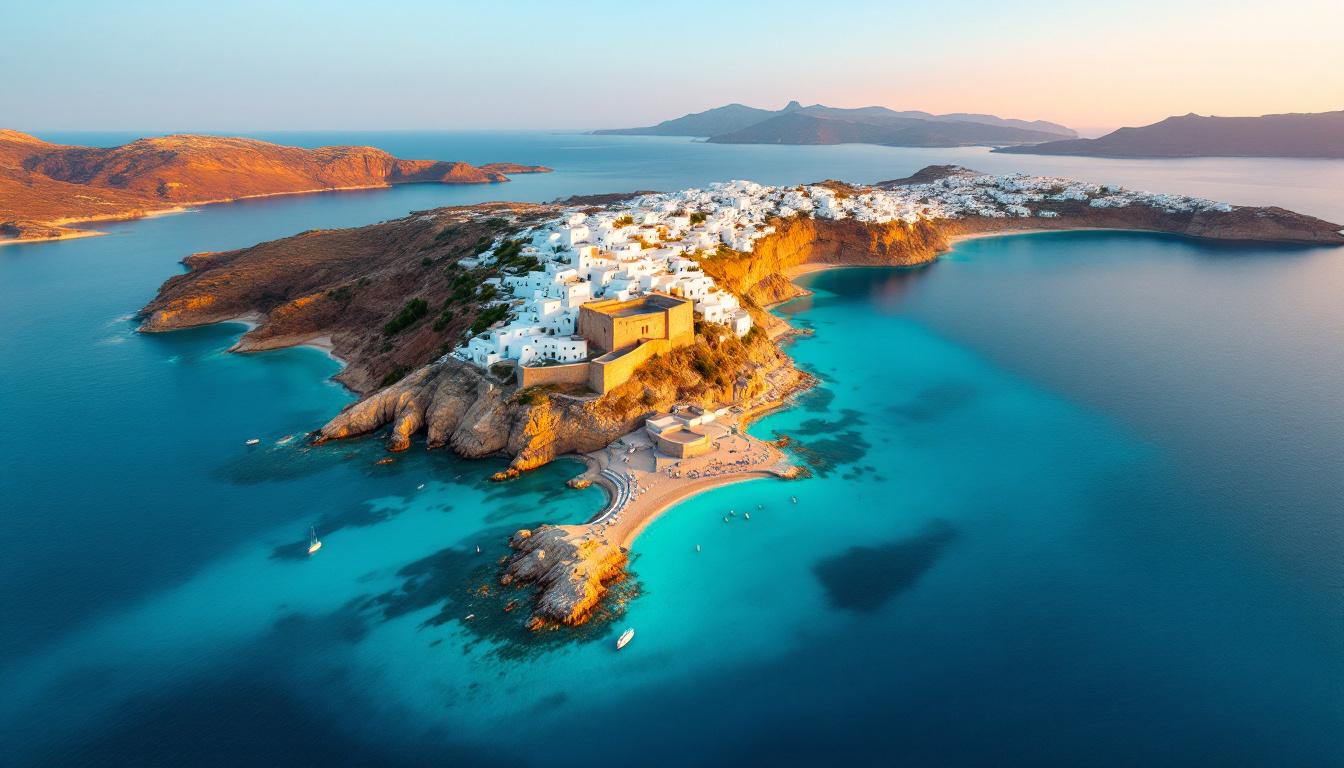Picture the Maldives’ signature turquoise lagoons and powder-white beaches, then imagine discovering them nestled in the heart of the Aegean Sea. Astypalaia, a butterfly-shaped Greek island in the Dodecanese, delivers those same breathtaking visuals that make the Maldives famous—but with ancient Venetian castles perched on clifftops and zero overwater bungalows cluttering the horizon.
What sets this hidden gem apart isn’t just its striking resemblance to tropical paradise. This tiny island runs on cutting-edge sustainable technology and harbors 2,500-year-old cultural treasures that the Maldives simply can’t match.
While Instagram feeds overflow with identical Maldivian resort shots, Astypalaia offers something genuinely rare: pristine beauty without the environmental guilt or crowds that plague tropical hotspots.
The visual twin that outshines its tropical cousin
Butterfly wings meeting crystal waters
Astypalaia’s distinctive shape mirrors the Maldives’ scattered atolls, with two “wings” connected by a narrow isthmus where the main town Chora sits like a crown jewel. Aerial views reveal the same mesmerizing contrast of white architecture against impossibly blue waters that make the Maldives so photogenic.
Beaches that rival paradise without the price tag
Beaches like Agios Konstantinos and Ble Limanaki showcase the same crystal-clear waters and hidden coves that define Maldivian luxury. The difference? Pebbled shores rich with marine life replace generic sandy beaches, while dramatic rocky coastlines create natural infinity pools perfect for snorkeling adventures.
Green innovation the Maldives wishes it had
Smart island technology leading the Mediterranean
While the Maldives struggles with waste management and carbon emissions from constant seaplane transfers, Astypalaia pioneers sustainable tourism through its Astymove electric vehicle system. This groundbreaking mobility network eliminates fossil fuel dependency while providing seamless island exploration.
Conservation success without resort restrictions
Unlike the Maldives’ resort-centric development that restricts local access, Astypalaia maintains low-density tourism that preserves both natural landscapes and authentic community life. Protected hiking trails lead to secluded beaches like Plakes, accessible only to respectful travelers willing to explore beyond the obvious.
Ancient stories the Maldives cannot tell
Venetian legacy crowning the butterfly
The 13th-century Querini Castle dominates Chora’s skyline, built atop Byzantine ruins that layer millennia of Mediterranean history into every stone. These panoramic ramparts offer views across both “wings” of the island—a perspective no Maldivian resort can provide.
Living traditions beyond luxury amenities
Panagia Portaitissa Church hosts authentic community celebrations every August 15th, featuring free communal feasts that welcome travelers into genuine Greek hospitality. This cultural depth contrasts sharply with the Maldives’ imported resort entertainment designed for detached luxury consumption.
Practical paradise without the Maldivian premium
August accessibility that actually makes sense
Reaching Astypalaia requires an 8-hour ferry from Athens or seasonal flights starting around €200—a fraction of Maldivian seaplane transfers. Boutique accommodations in Chora offer authentic Cycladic charm without overwater bungalow price tags, while Mediterranean alternatives provide backup options if crowds appear.
Weather that works with your schedule
August brings consistent sunshine and warm seas perfect for swimming, while afternoon winds create ideal conditions for exploring Chora’s cobblestone lanes during local siesta hours. Unlike the Maldives’ unpredictable monsoon seasons, Astypalaia’s weather patterns remain reliably pleasant throughout peak travel months.
Authentic experiences beyond resort boundaries
Wander through Chora’s windmill-lined streets where eight traditional mills frame postcard-perfect sunset views. Hike goat trails to hidden coves where local fishermen share stories over morning coffee, or join evening festivals where community members prepare traditional feasts using recipes passed down through generations.
While the Maldives confines visitors to resort islands with manufactured experiences, Astypalaia invites authentic cultural immersion. Island communities throughout the Mediterranean offer similar genuine connections, but few combine Astypalaia’s visual drama with such accessible sustainability initiatives.
This Greek island proves that paradise doesn’t require overwater bungalows or carbon-heavy logistics. Sometimes the most breathtaking destinations are those that look familiar but offer something completely different—ancient wisdom, environmental leadership, and authentic community spirit that no resort can replicate.
